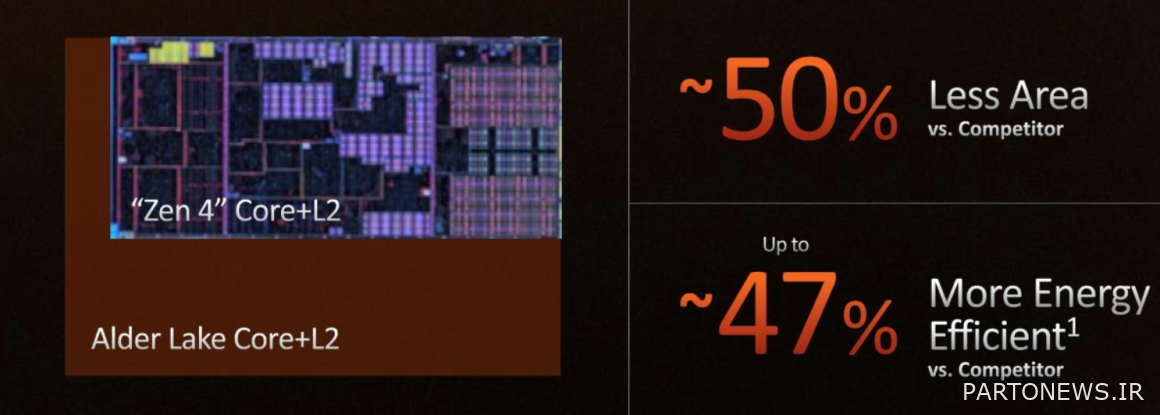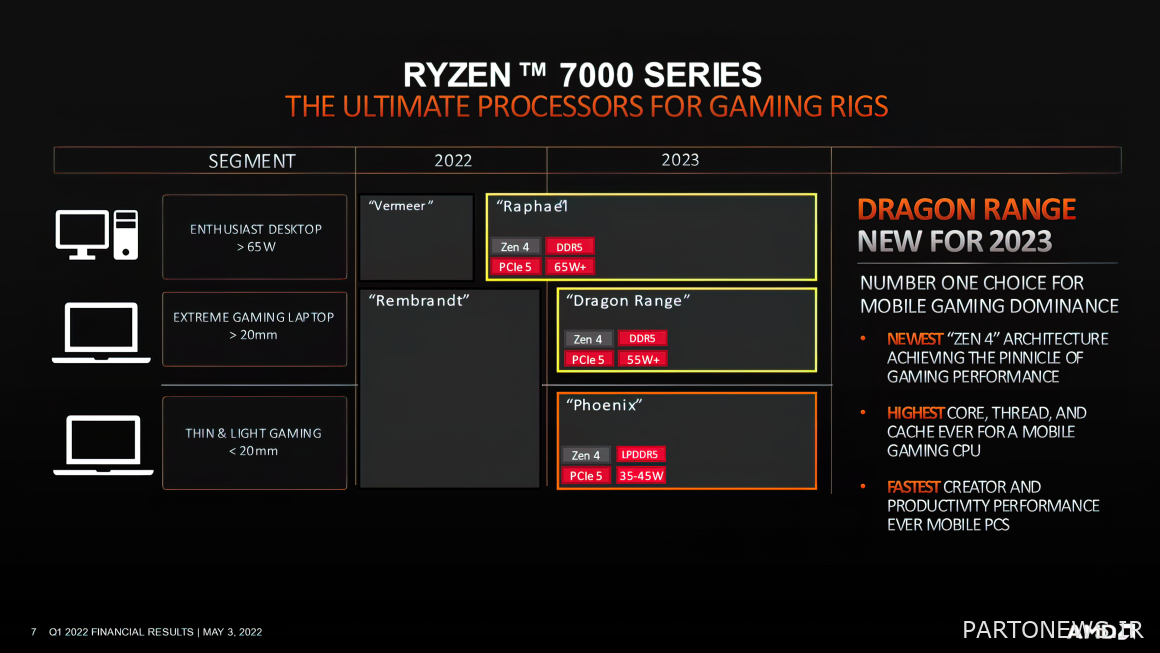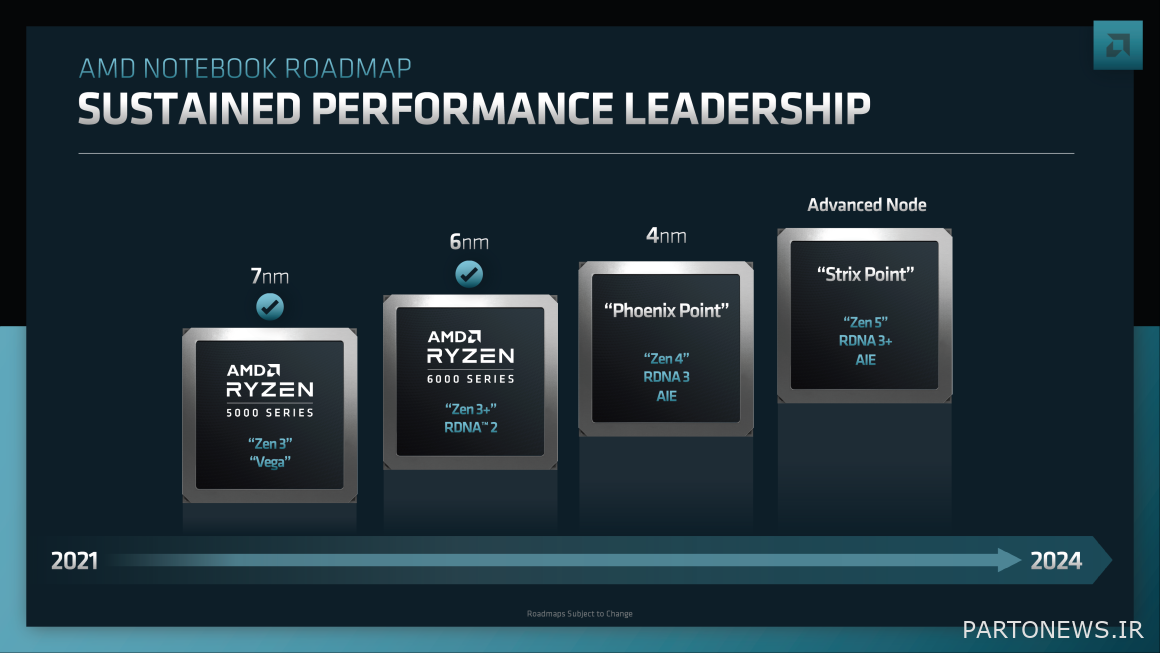Information about Dragon Range processors – outstanding performance and productivity waiting for laptops

AMD has recently introduced its new processors with 5nm Zen 4 architecture, which undoubtedly includes interesting points. according to the cause Informational We will review the Dragon Range processors, which will be released for laptops in early 2023 alongside the Phoenix Point model.
One of the most interesting slides that Red Team shared in the introduction of Ryzen 7000 was undoubtedly the generation-to-generation performance and higher productivity of Zen 4 compared to Zen 3. AMD used the 16-core Ryzen 9 7950X flagship model against the previous-generation flagship Ryzen 9 5950X (with 16 cores) to share the results below.
- Up to 35% faster performance at 170W thermal power
- Up to 37% faster performance at 105W thermal power
- Up to 74% faster performance at 65W thermal power
The mentioned numbers are significant, but the difference in power is 65 watts in our opinion. We know these results are best case scenario, but a 74% advantage for the Zen 4 would be unmatched. As mentioned, AMD is working on two mobile lineups for 2023, which are called Dragon Range and Phoenix Point.
The Dragon Range family is intended for the high-end category with more cores, threads and cache, while the Phoenix Point is used for conventional models. The first series will have a thermal power of more than 55 watts, but the second series will offer a thermal power of 35 to 45 watts. Of course, 55 watts is for the base configuration and we expect some more powerful laptops to be equipped with 65 watts of power.
Considering that AMD’s current line-up in laptops is limited to 8 cores and 16 threads, Red Team offers up to 16 cores and 32 threads with the Dragon Range series. Also, more cache memory, up to 80 MB compared to 20 MB of the best current model (Ryzen 9 6980HX) is considered. Considering the 74% improvement compared to Zen 3 in thermal power of 65W, this series can easily surpass the current Alder Lake HX lineup with 16 cores and 24 threads.
Information about Dragon Range notebook processors

AMD claims that the 5nm Zen 4 core consumes about 47% less power than the powerful P core with Alder Lake’s Golden Cove architecture. At the same time, 49% better performance than Zen 3 in the same power or 62% less energy consumption with the same performance is also announced. With 16 cores and the power of Zen 4, AMD seems to be taking mobile chip performance to a new level.
In our Alder Lake HX reviews, we saw that despite better performance in some cases due to poor cooling and the fact that the power consumption of the chips is 70 to more than 200 watts (according to PCWorld review), there are also problems. The Dragon Range may not only offer better performance than the Alder Lake HX, but also better power consumption and heat. However, it is still too early to draw such a conclusion.

At the same time, the Zen 4 architecture is also used for Phoenix Point chips, which will have an integrated package design. This series will still retain 8 cores and 16 threads, but the amount of cache will increase from 20 to 24 MB. Although these models are used for relatively weaker laptops, they can still provide a significant performance improvement over the current Zen 3 and Zen 3 Plus models.
One of the main advantages of Phoenix Point can undoubtedly be the unparalleled energy efficiency in the gaming category. Recently, we saw that the market of handheld gaming consoles has received special attention from different brands. The Ryzen 5000 and Ryzen 6000 mobile series are the main choices, while a model like the Steam Deck also uses a custom APU.
Another key category that Zen 4 can strengthen is the Genoa and Bergamo server platform and chips. Considering the environment in which the server chips operate, AMD’s new 5nm cores can provide maximum productivity and completely beat Intel’s Xeon chips.

AMD’s mobile lineup of Dragon Range and Phoenix Point should go up against the Raptor Lake P and Raptor Lake HX models, which will likely be unveiled around CES 2023.
| Processor series | AMD Strix Point H | AMD Dragon Range H | AMD Phoenix H | AMD Rembrandt H | AMD Cezanne H | AMD Renoir H | AMD Picasso H | AMD Raven Ridge H |
| Family | AMD Ryzen 8000 | AMD Ryzen 7000 | AMD Ryzen 7000 | AMD Ryzen 6000 | AMD Ryzen 5000 | AMD Ryzen 4000 | AMD Ryzen 3000 | AMD Ryzen 2000 |
| Construction technology | Unknown | 5 nm | 4 nm | 6 nm | 7 nm | 7 nm | 12 nm | 14 nm |
| CPU architecture | Zen 5 | Zen 4 | Zen 4 | Zen 3+ | Zen 3 | Zen 2 | Zen+ | Zen 1 |
| Max number of cores/threads | Unknown | 16 / 32 | 8/16 | 8/16 | 8/16 | 8/16 | 4/8 | 4/8 |
| Maximum level two cache | Unknown | 4 MB | 4 MB | 4 MB | 4 MB | 4 MB | 2 MB | 2 MB |
| Maximum cache level three | Unknown | 32 MB | 16 MB | 16 MB | 16 MB | 8 MB | 4 MB | 4 MB |
| Maximum CPU frequency | Unknown | Unknown | Unknown | Unknown | 4.8 GHz (Ryzen 9 5980HX) | 4.3 GHz (Ryzen 9 4900HS) | 4.0 GHz (Ryzen 7 3750H) | 3.8 GHz (Ryzen 7 2800H) |
| Integrated graphic architecture | RDNA 3+ | RDNA 2 | RDNA 3 | RDNA 2 | Vega Enhanced | Vega Enhanced | Vega | Vega |
| Maximum number of graphics cores | Unknown | Unknown | Unknown | Unknown | 8 computing units 512 cores | 8 computing units 512 cores | 10 computing units 640 cores | 11 computing units 704 core |
| Maximum graphics frequency | Unknown | Unknown | Unknown | Unknown | 2100 MHz | 1750 MHz | 1400 MHz | 1300 MHz |
| thermal power | Unknown | More than 55 watts (adjustable to 65 watts) | 35 to 45 watts (adjustable to 65 watts) | 35 to 45 watts (adjustable to 65 watts) | 35 to 54 watts (adjustable to 54 watts) | 35 to 45 watts (adjustable to 65 watts) | 12 to 35 watts (adjustable to 35 watts) | 35 to 45 watts (adjustable to 65 watts) |
| supply time | 2024 | The first season of 2023 | The first season of 2023 | The first season of 2022 | The first season of 2021 | The second season of 2020 | The first season of 2019 | The fourth season of 2018 |
Points: 5.0 out of 5 (1 vote)
wait a little…

